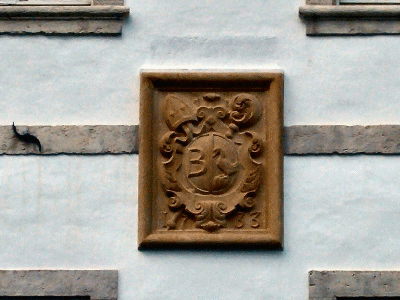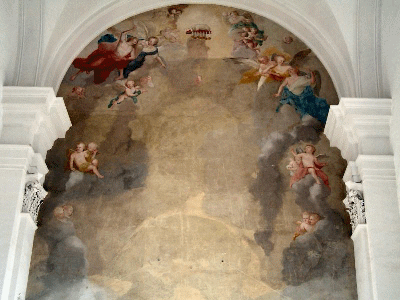
Bellelay Abbey
Encyclopedia

Premonstratensian
The Order of Canons Regular of Prémontré, also known as the Premonstratensians, the Norbertines, or in Britain and Ireland as the White Canons , are a Catholic religious order of canons regular founded at Prémontré near Laon in 1120 by Saint Norbert, who later became Archbishop of Magdeburg...
monastery in the Bernese Jura
Bernese Jura
Bernese Jura is the name for the French-speaking area of the Swiss canton of Bern, and from 2010 one of five administrative divisions of the canton....
in Switzerland
Switzerland
Switzerland name of one of the Swiss cantons. ; ; ; or ), in its full name the Swiss Confederation , is a federal republic consisting of 26 cantons, with Bern as the seat of the federal authorities. The country is situated in Western Europe,Or Central Europe depending on the definition....
, now a psychiatric clinic.
History
According to the legend, the monastery was founded in 1136 by Siginand, prior of the abbey of Moutier-GrandvalMoutier
Moutier is a municipality in the Jura bernois administrative district in the canton of Bern in Switzerland. It is located in the French-speaking Bernese Jura .-History:...
, who got lost in the deep forest of the High Jura while hunting a wild boar and was unable to find his way out. He vowed to found a monastery if he managed to return safely to Moutier, which he did four days later. To the monastery he founded in accordance with his vow he gave the name of "belle laie" ("laie" is a female wild boar).
According to other sources, the monastery was probably founded as a result of the influence of the Bishop of Basle on the south-west border of the diocese of Basle with the territory of the Abbot of Moutier-Grandval.
The foundation was confirmed by Pope Innocent II
Pope Innocent II
Pope Innocent II , born Gregorio Papareschi, was pope from 1130 to 1143, and was probably one of the clergy in personal attendance on the antipope Clement III .-Early years:...
in 1142. There are numerous spelling variations from the early years of the monastery: Balelaia, Belelagia, Belelai, Belilaia, Bellale, Bella Lagia, Bellelagia and Bellilagia. The name comes from the Vulgar Latin
Vulgar Latin
Vulgar Latin is any of the nonstandard forms of Latin from which the Romance languages developed. Because of its nonstandard nature, it had no official orthography. All written works used Classical Latin, with very few exceptions...
bella lagia ("beautiful forest").

Grenzach-Wyhlen
Grenzach-Wyhlen is a municipality in the district of Lörrach in Baden-Württemberg, Germany. It is situated on the right bank of the Rhine, 7 km east of Basel, and 8 km south of Lörrach. It has borders to Inzlingen and Rheinfelden and Riehen , Birsfelden and Kaiseraugst in...
in Baden-Württemberg
Baden-Württemberg
Baden-Württemberg is one of the 16 states of Germany. Baden-Württemberg is in the southwestern part of the country to the east of the Upper Rhine, and is the third largest in both area and population of Germany's sixteen states, with an area of and 10.7 million inhabitants...
.
Bellelay was under the authority of the diocese of Basle, but operated as an independent lordship under the terms of a protection contract agreed with Bern and Solothurn
Solothurn
The city of Solothurn is the capital of the Canton of Solothurn in Switzerland. The city also comprises the only municipality of the district of the same name.-Pre-roman settlement:...
(by 1414 at the latest) and also with Biel
Biel/Bienne
Biel/Bienne is a city in the district of the Biel/Bienne administrative district in the canton of Bern in Switzerland.It is located on the language boundary and is throughout bilingual. Biel is the German name for the town, Bienne its French counterpart. The town is often referred to in both...
in 1516.
Although the abbot had the right of the low justice in the abbey's immediate territory, and was awarded the right to the use of the ring, the mitre and the cross at the Council of Constance
Council of Constance
The Council of Constance is the 15th ecumenical council recognized by the Roman Catholic Church, held from 1414 to 1418. The council ended the Three-Popes Controversy, by deposing or accepting the resignation of the remaining Papal claimants and electing Pope Martin V.The Council also condemned and...
in 1414, it does not seem that Bellelay was ever an Imperial abbey.
The buildings were ransacked during the Swabian War
Swabian War
The Swabian War of 1499 was the last major armed conflict between the Old Swiss Confederacy and the House of Habsburg...
in 1499 but thanks to the treaty with Solothurn the monastery was spared the effects of the Thirty Years' War
Thirty Years' War
The Thirty Years' War was fought primarily in what is now Germany, and at various points involved most countries in Europe. It was one of the most destructive conflicts in European history....
. The abbey reached its golden age in the 18th century as a renowned place of education for the sons of European nobility.
Dissolution
In 1797 the buildings were occupied by French troopsFrance
The French Republic , The French Republic , The French Republic , (commonly known as France , is a unitary semi-presidential republic in Western Europe with several overseas territories and islands located on other continents and in the Indian, Pacific, and Atlantic oceans. Metropolitan France...
and secularised. The precious furnishings were sold at this time - an altar from Bellelay, for example, is now to be found in the parish church of Our Lady of the Assumption in Saignelégier
Saignelégier
Saignelégier is a municipality in the canton of Jura in Switzerland. It is the seat of the district of Franches-Montagnes. On 1 January 2009, the formerly independent municipalities of Goumois and Les Pommerats merged into Saignelégier....
.
In the 19th century the monastery premises were used as a watch factory, then as a brewery and finally as a glass factory. In 1890 the Canton of Bern acquired the site, from which time the monastery buildings have been used as a psychiatric clinic.
Since the end of the 1960s the premises have also been used for concerts and exhibitions by the Fondation de l'Abbatiale de Bellelay.
Architecture

Franz Beer
Franz Beer , also known as Franz Beer von Blaichten, was an Austrian architect during the Baroque period, mainly working on church buildings at monasteries in southern Germany, chiefly in Upper Swabia, and Switzerland. His son Johann Michael Beer also was an architect.Born in Au im Bregenzerwald in...
on the Vorarlberg
Vorarlberg
Vorarlberg is the westernmost federal-state of Austria. Although it is the second smallest in terms of area and population , it borders three countries: Germany , Switzerland and Liechtenstein...
model between 1708 and 1714. The church has two towers on the west front which formerly had onion domes. The interior is decorated with painted stucco by the Wessobrunn School
Wessobrunner School
The Wessobrunner School is the name for a group of Baroque stucco-workers that, beginning at the end of the 17th century, developed in the Benedictine Wessobrunn Abbey in Bavaria, Germany....
, created in 1713. The other monastery buildings in the Baroque
Baroque
The Baroque is a period and the style that used exaggerated motion and clear, easily interpreted detail to produce drama, tension, exuberance, and grandeur in sculpture, painting, literature, dance, and music...
style are also from the 18th century.
Tête de Moine
Bellelay Abbey is the home of the cheese Tête de MoineTête de Moine
Tête de Moine is a Swiss cheese. Its name, which means "Monk's Head", is derived from its invention and initial production by the monks of the abbey of Bellelay, located in the community of Saicourt, district of Moutier, in the mountainous zone of the Bernese Jura, the French-speaking area of the...
, first made by the monks in the 12th century.
List of Abbots of Bellelay
- Geroldus 1142–1180
- Ludovicus 1187–1202
- Adam 1195
- Richardus 1202–1237
- Henricus I of Soulce 1237–1256
- Jacobus I von Wetterau 1256–1258
- Conradus 1258–1270
- Name unknown, possibly died 1276
- Petrus I of Varres 1289–1296
- Burchardus of Boécourt 1298–1316
- Lambertus 1316–1326
- Petrus II de Sancey 1326–1336
- Henricus II de Bassecourt 1337–1350
- Petrus III de Vannes 1350–1354
- Jacobus II de Séprais 1365–1374
- Joannes III de Pontenet 1374–1398
- Joannes IV Donzelat 1398–1401
- Henricus III Nerr 1401–1418
- Heinzmann (Henricus IV) Girardin 1418–1426
- Joannes V de Chatelat 1426–1434
- Petrus IV Martini 1434–1438
- Heinzmann (Henricus V) 1438–1448
- Joannes VI Rier 1448–1456
- Joannes VII Gruel or Grier 1456–1483
- Joannes VIII Barth 1483–1490
- Joannes IX Brullard 1490–1508
- Nicolaus I Schnell 1508–1530
- Joannes X Gogniat 1530–1553
- Servatius Fridez 1553–1561
- Antonius Fottel 1561–1574
- Joannes XI Simon 1574–1579
- Werner Spiessbrecher (Brieselance) 1579–1612
- David Juillerat 1612–1637
- Joannes XII Petrus Cuénat 1637–1666
- Joanns XIII Georgius Schwaller 1666–1691
- Norbertus Périat 1691–1692
- Fridericus de Staal 1692–1706
- Joannes XIV Georgius Voirol 1706–1719
- Joannes XV Sémon 1719–1743
- Gregorius Joliat 1743–1771
- Nicolaus II Deluce 1771–1784
- Ambrosius Monnin 1784–1807
Sources
- The reproduction of the Bossard organ from 1721 by Kuhn Organ Builders Ltd.
- Fondation de l'abbatiale de Bellelay /
- Website source of list of abbots

